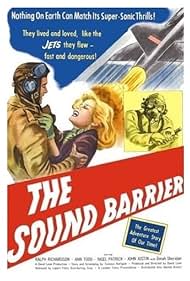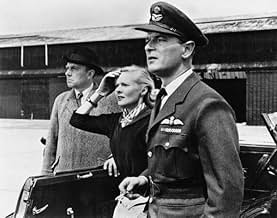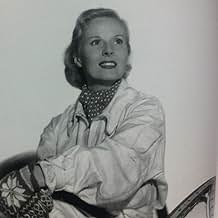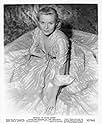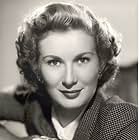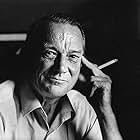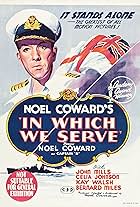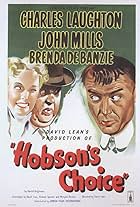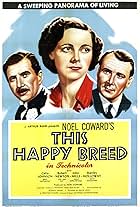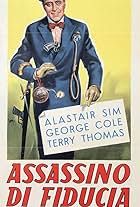VALUTAZIONE IMDb
6,7/10
2427
LA TUA VALUTAZIONE
Ingegneri aerospaziali britannici risolvono il problema del volo supersonico.Ingegneri aerospaziali britannici risolvono il problema del volo supersonico.Ingegneri aerospaziali britannici risolvono il problema del volo supersonico.
- Vincitore di 1 Oscar
- 9 vittorie e 5 candidature totali
Rodney Goodall
- Little Boy
- (non citato nei titoli originali)
Donald Harron
- ATA Officer
- (non citato nei titoli originali)
Vincent Holman
- Factor
- (non citato nei titoli originali)
Jolyon Jackley
- Susan's Baby
- (non citato nei titoli originali)
Douglas Muir
- Controller
- (non citato nei titoli originali)
Leslie Phillips
- Controller
- (non citato nei titoli originali)
Anthony Snell
- Peter Makepeace
- (non citato nei titoli originali)
Sally-Jane Spencer
- Daughter of Philip
- (non citato nei titoli originali)
Robert Brooks Turner
- Test Bed Operator
- (non citato nei titoli originali)
Trama
Lo sapevi?
- QuizThe flying sequences under the direction of Anthony Squire, were based at the Vickers aerodrome at Chilbolton near Nether Wallop in Hampshire. Squire managed to secure one of the last airworthy Avro Lancaster bombers for the task. The cameramen were positioned in the front and rear turrets while Squire conducted proceedings from the central astrodome. The Lancaster was replaced by a Vickers Valetta after all, but Squire had fallen asleep due to an oxygen supply failure. Luckily as he recalled, "They all woke up on the way down, like people in a fairy wood, but I didn't bother with the Lancaster again."
- BlooperIn the observatory, John tells Tony that the Andromeda galaxy is 700,000 light-years away; The best estimate since 1940 (when the known Cepheid variables were separated in two types by Baade) is 2.54 million light-years, BUT: this corresponds to 778,000 parsecs! So, it seems that parsecs and light years were somehow switched here in the movie.
- Citazioni
Susan Garthwaite: [regarding an image of the surface of the moon, displayed via JR's telescope] What's that?
John Ridgefield: It's the moon.
Susan Garthwaite: I never knew it could look so unfriendly.
John Ridgefield: It's an unfriendly universe.
Susan Garthwaite: Do you believe that?
John Ridgefield: Unfriendly only because it's unconscious of our existence.
- Curiosità sui creditiIn the opening credits, immediately after the human actors, are listed four British aircraft: The de Havilland COMET The Vickers-Supermarine ATTACKER The de Havilland VAMPIRE 113 The Vickers-Supermarine SWIFT Rolls-Royce 'Avon' Engine
- ConnessioniFeatured in Jet! When Britain Ruled the Skies: Military Marvels (2012)
- Colonne sonoreWith Sword and Lance
(uncredited)
Music by Hermann Starke
Recensione in evidenza
A young RAF pilot test's his father-in-law's prototype supersonic aircraft to the limit, at a time of intense development activity in the field of aviation, just as commercial jet airliners are about to come into service.
This is one of David Lean's less well-known films, in which some of the development milestones and incidents in contemporary UK aviation were put into a dramatic context. It should be mentioned that the aero industry was probably the UK's largest single industry by the end of WWII; it is thought that approximately 25% of the entire UK economy was devoted to aircraft manufacturing and allied industries; for four long years air power had been Britain's main means of striking back at Germany. Although activities were somewhat reduced in peacetime, the UK lead the way in several key aviation fields in the late 1940s and early 1950s; there was a new Cold War to be fought.
Now, lot of reviews here assume that the events portrayed were completely fictional (a la U571); whilst no film is beyond reproach in this respect in point of fact in this case nothing could be further from the truth; this film used no fewer than eight of the UK's most experienced test pilots as consultants. One of the eight, John Derry, reached supersonic speeds on 9th september 1948, whilst in a shallow dive in the third DH108 prototype.
The phenomenon of 'control reversal' at transonic speeds can and does occur with some wing designs; essentially at very high speeds the angle of attack of the wing is dramatically altered (because the control surface loads twist the wing essentially) and thus the intended effect of the controls can be reversed. This phenomenon is known to have afflicted aircraft such as early marks of spitfire, and this could limit the safe speed in a dive until a (torsionally stiffer) revised wing was introduced. It is just one of the many things that can occur in or near the transonic regime, and was probably chosen for the film because it is both simple and dramatic, and by then fairly well-known.
Flying military jet aircraft at that time was incredibly dangerous even without being shot at; peacetime training accidents were numerous. On some types an aircraft would be lost for every 1000 hours flying time and in a little under half of those losses the pilot was killed too. Test pilots had it worse than that; one of the eight test pilots who was consultant on this film was credited posthumously; he passed away between when the film was shot and released. Indeed the film refers to the loss of Geoffrey de Havilland (which in reality occured in 1946) again in a DH108 prototype. It is sobering to note that there are no surviving DH108 prototypes because they were all lost in (fatal) crashes.
In this film the human drama is played well enough with fine ating and good production values, but all this definitely takes second place to the aircraft and the flying. We see (apparently) a wartime spitfire in a high speed dive, Supermarine Attacker WA485, De Havilland Comet G-ALYR, a De Havilland Vampire and a Supermarine Swift.
In one magical sequence they have breakfast in the UK, fly to Cairo for lunch whilst delivering an aircraft, and then cadge a ride home on a Comet undergoing evaluation testing for BOAC. All at high altitude, high speed, jet-smooth, way above the clouds; something airline passengers of the time could only imagine until the Comet entered service during 1952.
Comet G-ALYR (one of the first batch of production Comet Mk 1 aircraft) was badly damaged in a taxi-ing accident a year or so after this film was made. Nonetheless it had already flown about 750 times and the fuselage was eventually used for water-tank fatigue testing, the lessons of which were learned from world-wide and are still relevant to this day.
This film isn't technically perfect but it is by no means as flawed as others would have you believe. It is stronger as a film about flying than a drama, but it is by no means bad in either respect. It gets a solid 8/10 from me.
This is one of David Lean's less well-known films, in which some of the development milestones and incidents in contemporary UK aviation were put into a dramatic context. It should be mentioned that the aero industry was probably the UK's largest single industry by the end of WWII; it is thought that approximately 25% of the entire UK economy was devoted to aircraft manufacturing and allied industries; for four long years air power had been Britain's main means of striking back at Germany. Although activities were somewhat reduced in peacetime, the UK lead the way in several key aviation fields in the late 1940s and early 1950s; there was a new Cold War to be fought.
Now, lot of reviews here assume that the events portrayed were completely fictional (a la U571); whilst no film is beyond reproach in this respect in point of fact in this case nothing could be further from the truth; this film used no fewer than eight of the UK's most experienced test pilots as consultants. One of the eight, John Derry, reached supersonic speeds on 9th september 1948, whilst in a shallow dive in the third DH108 prototype.
The phenomenon of 'control reversal' at transonic speeds can and does occur with some wing designs; essentially at very high speeds the angle of attack of the wing is dramatically altered (because the control surface loads twist the wing essentially) and thus the intended effect of the controls can be reversed. This phenomenon is known to have afflicted aircraft such as early marks of spitfire, and this could limit the safe speed in a dive until a (torsionally stiffer) revised wing was introduced. It is just one of the many things that can occur in or near the transonic regime, and was probably chosen for the film because it is both simple and dramatic, and by then fairly well-known.
Flying military jet aircraft at that time was incredibly dangerous even without being shot at; peacetime training accidents were numerous. On some types an aircraft would be lost for every 1000 hours flying time and in a little under half of those losses the pilot was killed too. Test pilots had it worse than that; one of the eight test pilots who was consultant on this film was credited posthumously; he passed away between when the film was shot and released. Indeed the film refers to the loss of Geoffrey de Havilland (which in reality occured in 1946) again in a DH108 prototype. It is sobering to note that there are no surviving DH108 prototypes because they were all lost in (fatal) crashes.
In this film the human drama is played well enough with fine ating and good production values, but all this definitely takes second place to the aircraft and the flying. We see (apparently) a wartime spitfire in a high speed dive, Supermarine Attacker WA485, De Havilland Comet G-ALYR, a De Havilland Vampire and a Supermarine Swift.
In one magical sequence they have breakfast in the UK, fly to Cairo for lunch whilst delivering an aircraft, and then cadge a ride home on a Comet undergoing evaluation testing for BOAC. All at high altitude, high speed, jet-smooth, way above the clouds; something airline passengers of the time could only imagine until the Comet entered service during 1952.
Comet G-ALYR (one of the first batch of production Comet Mk 1 aircraft) was badly damaged in a taxi-ing accident a year or so after this film was made. Nonetheless it had already flown about 750 times and the fuselage was eventually used for water-tank fatigue testing, the lessons of which were learned from world-wide and are still relevant to this day.
This film isn't technically perfect but it is by no means as flawed as others would have you believe. It is stronger as a film about flying than a drama, but it is by no means bad in either respect. It gets a solid 8/10 from me.
I più visti
Accedi per valutare e creare un elenco di titoli salvati per ottenere consigli personalizzati
- How long is The Sound Barrier?Powered by Alexa
Dettagli
- Data di uscita
- Paese di origine
- Lingua
- Celebre anche come
- Breaking the Sound Barrier
- Luoghi delle riprese
- Chilbolton Aerodrome, Nether Wallop, Hampshire, Inghilterra, Regno Unito(flying sequences)
- Aziende produttrici
- Vedi altri crediti dell’azienda su IMDbPro
Botteghino
- Budget
- 250.000 £ (previsto)
- Tempo di esecuzione1 ora 58 minuti
- Colore
- Proporzioni
- 1.37 : 1
Contribuisci a questa pagina
Suggerisci una modifica o aggiungi i contenuti mancanti

Divario superiore
By what name was Ali del futuro (1952) officially released in India in English?
Rispondi